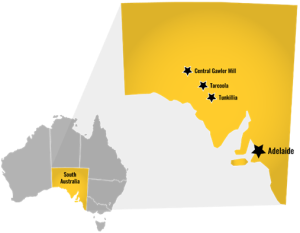Santana Equestrian Private Financial, Inc. (OTC PINK:SEQP) Achieves OTCID™ Compliance and Showcases
WELLINGTON, FL / ACCESS Newswire / July 23, 2025 / Santana Equestrian Private Financial, Inc. (“SEQP”) has confirmed its compliance with OTCID™ Basic Market reporting standards and outlined a strategic expansion designed to bridge physical commodity operations with financial market opportunities. The Company’s latest initiatives emphasize asset-backed scalability, ESG-linked cash flows, and institutional-grade risk management – positioning SEQP as a physical-to-financial infrastructure bridge in the sustainable commodities sector.
-
OTCID™ Basic Market Compliance – SEQP met all requirements under OTC Markets Group’s new OTCID Basic tier as of July 1, 2025, including a verified corporate profile, management certification, news service subscription, transfer agent verification, and timely disclosure commitments. This ensures full transparency and active engagement with U.S. regulators and investors, preventing any downgrade to limited trading tiers.
-
Regulatory Tailwind (Florida HB 211) – A new Florida law (HB 211) effective July 1, 2025 expands the definition of “farm product” to include biomass – such as plant, animal, and equine waste – and prohibits local restrictions on those farm operations. This legal clarity enables SEQP to process equine and yard biomass on-site as an agricultural activity, providing a significant operational advantage.
-
Integrated ESG Revenue Streams – SEQP is leveraging HB 211 by expanding into two synergistic divisions that convert waste and land into value: on-site equestrian biomass processing and distressed farmland reclamation. Together, these create a multi-asset commodity risk platform linking physical infrastructure (collection systems, land assets) with financial outputs (carbon credits, land appreciation), yielding scalable ESG-linked revenue streams.
-
New Revenue Potential – By bridging real assets with environmental commodities, SEQP projects substantial new cash flows. Voluntary carbon credits priced at ~$10-$30/ton could generate $1-$3 million in annual revenue within 18 months. Improved soil output and land remediation are expected to drive 15-25% ROI through land-value uplift, while on-site processing provides 20-40% logistics cost reduction and additional income from organic soil amendments.
-
Institutional Alignment – SEQP’s physical-to-financial commodity platform is built for prudent risk management and asset-backed growth, mirroring the frameworks of leading commodity finance institutions. The Company’s diversified, scalable ESG revenue stream – from carbon credits to rehabilitated land assets – positions it as a unique strategic fit for multi-asset trading platforms seeking sustainable commodity exposure.
OTCID™ Basic Market Compliance Achieved
SEQP today announced that it has successfully filed its OTCID Basic Market compliance package via OTCIQ, with effectiveness on July 1, 2025. This significant corporate action confirms that SEQP meets all baseline requirements of the OTC Markets’ new disclosure tier. The company’s profile is verified, management certifications are in place, news dissemination is active, and its transfer agent participates in the verified share program. SEQP is committed to timely quarterly and annual reports, corporate action notices, and insider disclosures, ensuring ongoing transparency. Maintaining these standards prevents any risk of downgrade to Pink Limited or Expert Market status and underscores SEQP’s dedication to robust governance and investor engagement.
“Achieving OTCID compliance provides a strong foundation of credibility as we scale our business,” said Paulo Santana, CEO & Founder of SEQP. “It signals to the market that we operate with full transparency and regulatory engagement, which is essential as we attract broader institutional interest.”
Strategic Expansion: Physical-to-Financial Commodity Platform & ESG Revenue Streams
With the tailwind of Florida House Bill 211 – which, as of July 1, 2025, classifies biomass (including equestrian waste) as a farm product and bars local restrictions on its processing – SEQP is launching an expanded business model converting agricultural byproducts and land assets into monetizable commodities. The Company’s strategy centers on two primary divisions:
-
On-Site Biomass Processing Division: Deploying modular biomass collection and composting systems directly at large equestrian venues. This on-location infrastructure is anticipated to cut waste transport costs by 20-40%, significantly lower carbon emissions, and produce high-quality compost. Importantly, processing manure and green waste at the source positions SEQP to generate voluntary carbon credits for emissions avoided, creating a direct revenue link from physical operations to environmental markets. This on-site model not only improves logistics efficiency but also reduces operational risk by localizing the supply chain (no reliance on distant landfills), while yielding tradable carbon assets.
-
Distressed Ag-Property Division: Acquiring underutilized or degraded rural parcels and rehabilitating them using SEQP’s proprietary BioActivium™ soil amendments. By improving soil carbon content and ecosystem health, these projects qualify for carbon sequestration credits under established registries like Verra and ACR. Each rehabilitated property becomes a productive agricultural asset with enhanced value and sustainable output. This approach effectively monetizes carbon and land in tandem: SEQP earns carbon credits for the verified greenhouse gas reductions, and the land itself appreciates (through higher fertility and utility), which can be leveraged for resale, refinancing, or crop revenue.
Through these dual initiatives, SEQP is transforming from a niche equine waste processor into a broad-based agritech and ESG enterprise. By integrating physical commodity infrastructure with financial instruments, the Company has established a bridge between on-the-ground operations and capital markets. Manure, stable bedding, and marginal farmland – traditionally seen as waste or low-value – are being converted into multi-dimensional assets. Specifically, physical outputs (such as compost and improved land yields) are coupled with intangible credits (carbon offsets and renewable energy attributes), all within one vertically integrated platform.
This integrated model functions as a multi-asset commodity risk platform internally: SEQP manages diverse but complementary asset classes (fertilizer inputs, real estate, carbon credits) under a unified strategy. The result is a balanced revenue portfolio that can hedge and offset risks – for example, carbon credit sales provide income independent of commodity crop prices, and land value gains provide underlying asset strength to counter market volatility. The physical-to-financial infrastructure that SEQP has built ensures that every operational improvement (physical) has a parallel financial realization, whether in the form of cost savings, credits, or asset appreciation.
Financial Highlights of the ESG Platform: Key metrics illustrate the scalability and economic potential of SEQP’s strategy:
-
Logistics Savings: On-site processing yields a 20-40% reduction in freight and disposal costs, directly improving margins and minimizing the carbon footprint of waste transport.
-
Carbon Credit Pipeline: Each ton of biomass processed can translate into marketable carbon credits (voluntary market rates ~$10-$30/ton) – SEQP is targeting $1-$3 million in annual carbon credit sales within 18 months as projects scale. These credits provide a scalable ESG revenue stream with low correlation to traditional agricultural income.
-
Land-Value Leverage: Reclaimed farms are expected to see 15-25% increases in land value (ROI) after soil restoration. This land-value leverage not only boosts SEQP’s asset base but can also support additional financing (using higher-value land as collateral) to fuel further growth.
-
Product Diversification: The proprietary organic soil amendments produced (branded as Activium™) create a new product line and revenue source. These adjacent financial opportunities – from selling soil enhancement products to potentially securitizing future carbon credit streams – add layers of value to SEQP’s portfolio beyond core operations.
Asset-Backed Scalability and Institutional Alignment
SEQP’s growth model is deliberately built on asset-backed scalability. Each new equestrian site outfitted with an on-site unit and each acre of land restored add tangible assets and cash flow to the Company’s balance sheet. This means expansion is underpinned by real collateral – physical equipment, land holdings, and verified carbon credits – rather than speculative ventures. Such an approach offers inherent stability and risk-efficient growth: assets on the ground support the enterprise value, and the diversified revenue streams (savings, sales, credits, and land appreciation) provide multiple buffers against single-market volatility.
Crucially, SEQP’s integrated commodity platform is aligned with the operational ethos of large-scale commodity and financial firms. By bridging physical operations with financial products, SEQP mirrors how institutional commodity desks operate – aggregating and converting raw inputs into tradeable outputs and managing risk across the value chain. The Company’s emphasis on prudent risk management and compliance further strengthens this alignment. Every expansion initiative undergoes rigorous evaluation for regulatory compliance (from environmental permits to HB 211 adherence) and market viability, ensuring that growth is both aggressive and disciplined.
This alignment positions SEQP as a potential strategic partner within the broader commodity finance ecosystem. The multi-asset profile of SEQP – encompassing elements of agriculture (land & soil), energy (biomass fuel potential), and environmental markets (carbon credits) – offers a microcosm of the diversified platforms run by global trading firms. Management believes that SEQP’s scalable ESG revenue streams, supported by hard assets and verified data, could seamlessly integrate into a larger multi-asset commodity risk platform. In effect, SEQP functions as a physical-to-financial infrastructure bridge, translating grassroots sustainable practices into institutional-grade financial performance indicators. This makes the Company’s model attractive for cross-industry collaboration, whether through offtake agreements, joint ventures, or integration with a Fortune-100 commodity network.
Paulo Santana, CEO & Founder of SEQP, emphasized the strategic significance of this approach in the context of industry trends:
“Thanks to Florida’s HB 211, SEQP can now legally process equine and yard biomass at source – an advance that not only reduces costs by up to 40%, but also positions us to generate carbon credits,” said Santana. “This regulatory clarity accelerates our on-site deployment and directly contributes to new ESG-linked cash flows from previously untapped waste resources.”
“Expanding into distressed ag-property acquisition and soil restoration transforms SEQP from a niche biomass processor into a scalable agritech and ESG powerhouse,” Santana continued. “In doing so, we have effectively built a platform that bridges physical commodity infrastructure with financial market value – a model where manure and marginal land are converted into tradeable credits and appreciating assets. This is exactly the kind of physical-to-financial integration that major commodity firms use to unlock value across markets.”
“We’re entering an imminent growth phase, supported by legislative clarity, diversified revenue streams, and tangible ESG impact,” added Santana. “Our strategy remains aggressive in scaling operations yet disciplined in risk management and compliance, aligning with the prudent frameworks of institutional players. We are committed to delivering asset-backed, scalable results that can stand alongside those of established commodity finance platforms.”
Risk & Forward-Looking Statements
SEQP reminds investors that certain statements in this announcement are forward-looking and involve known and unknown risks. Actual results could differ materially due to factors such as:
-
Regulatory Risk: Future changes to laws like HB 211 or carbon credit policies could impact SEQP’s operations and expansion plans.
-
Market Risk: Fluctuations in carbon credit pricing and agricultural commodity markets may affect revenue projections and project economics.
-
Execution Risk: Potential delays or challenges in land acquisition, soil remediation processes, or obtaining carbon credit certifications could alter timelines and outcomes.
-
Operational Risk: Scaling up in-field biomass collection and processing across multiple sites may present logistical or technical challenges that affect efficiency.
-
Financial Risk: The Company’s growth requires adequate funding; inability to secure necessary capital for property purchases or infrastructure build-out could slow planned expansion.
Management believes in the Company’s strategy and projections, but cautions that actual results may differ materially from forward-looking statements given these and other uncertainties. SEQP undertakes no obligation to update forward-looking information except as required by law. Investors are encouraged to review the Company’s OTCIQ filings for a comprehensive discussion of risks and assumptions.
Timeline & Next Steps
-
Carbon Credit Pilot Projects Launch: Q4 2025 – Initiation of on-site carbon capture and composting pilots at select equestrian venues.
-
First Agricultural Land Acquisition: Q1 2026 – Target timeline for closing the first distressed farmland acquisition under the new division, with remediation work commencing shortly thereafter.
-
Investor Webinar (ESG Focus): Date TBD – SEQP plans to host a detailed webinar outlining its ESG strategy, operational milestones, and financial projections for stakeholders.
About SEQP
Founded in 2018 and based in Wellington, Florida, Santana Equestrian Private Financial, Inc. (OTC PINK:SEQP) specializes in sustainable equestrian biomass management and regenerative agriculture. Through on-site waste-to-resource conversion, soil amendment production, carbon credit monetization, and land rehabilitation, SEQP aims to pioneer a new model of agritech that is both environmentally impactful and financially rewarding. The Company’s mission is to deliver tangible ESG results (reduced emissions, healthier soils) alongside attractive asset-backed returns, bridging the gap between traditional farming, waste management, and modern sustainable finance.
Investor Relations Contact:
Paulo Santana – CEO & Founder
Santana Equestrian Private Financial, Inc.
Tel: 561-308-8206
Email: santanafinancial@gmail.com
Website: www.bioactivium.com
This press release is intended to satisfy OTCID Basic Market transparency and disclosure standards. SEQP remains committed to ongoing compliance and to delivering clear, consistent, and accurate information to the investing public.
SOURCE: Santana Equestrian Private Financial
View the original press release on ACCESS Newswire

















